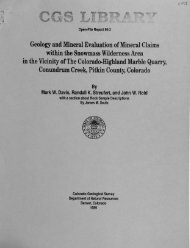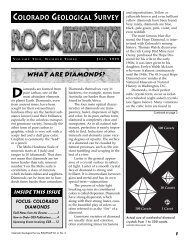Central City Historic Mining Districts - Colorado Geological Survey
Central City Historic Mining Districts - Colorado Geological Survey
Central City Historic Mining Districts - Colorado Geological Survey
You also want an ePaper? Increase the reach of your titles
YUMPU automatically turns print PDFs into web optimized ePapers that Google loves.
Gilpin County<br />
<strong>Central</strong> <strong>City</strong> and Idaho Springs <strong>Districts</strong><br />
The <strong>Central</strong> <strong>City</strong> and Idaho Springs <strong>Districts</strong> are geologically the northern end of a continuous belt of mineralization<br />
extending from the Rollinsville Placers to Idaho Springs on the south. It is commonly considered to contain the following<br />
smaller districts: Bay State, <strong>Central</strong> <strong>City</strong>, Enterprise, Eureka, Gregory, Nevada, Pleasant Valley, Quartz Hill, and<br />
Russell Gulch.<br />
After the early discovery of gold in Clear Creek County, placer districts were developed in the <strong>Central</strong> <strong>City</strong> District in<br />
Nevada and Illinois Gulches. Lode deposits were shortly discovered but lasted only as long as the oxidized ore. Sulfide<br />
ores made accessible by the construction of the Blackhawk smelter in 1868, which treated unoxidized ores from all the<br />
nearby districts. Koschmann and Bergendahl quote a number of 4,200,000 ounces produced through 1959 in the district,<br />
including 30,000 ounces from placer deposits.<br />
The geology was described by Moench, et al (1962) and Lovering and Goddard (1950). Precambrian gneisses and schists<br />
of the Idaho Springs Formation are injected with granodiorite also of Precambrian age. Later Tertiary porphyry intrusions<br />
of a range of compositions appear to have introduced the mineralization. Sims (1956) recognized four types of veins -<br />
pyrite-quartz; quartz-pyrite-chalcopyrite, tennanite (with some galena and sphalerite); pyritic lead-zinc veins of quartz,<br />
pyrite, galena, sphalerite with minor chalcopyrite and tennanite; and lead-zinc veins of quartz, galena, sphalerite,<br />
carbonate, and minor chalcopyrite, tennanite, and pyrite. Gold is present both in sulfides and as small native particles.<br />
Mines Reported (www.mindat.org)<br />
• Air Line<br />
• Eagle<br />
• Gold Crown Shaft<br />
• Great Britain<br />
• H. B. Shaft<br />
• Ida May Occurrence (Seven Forty; Barney; Polar Star; Alamaden; Standard; Lida; ; Fall River; Thomas; Golconda)<br />
• Idaho Tunnel<br />
• Bride Vein<br />
• Ingham<br />
• Lower Almaden Mine<br />
• Blazing Star Tunnel<br />
• Lyons<br />
• Magdalena<br />
• Mahany<br />
• Standard<br />
• Sub Treasury<br />
• University<br />
• Venice<br />
• Western Occurrence (Bald Mtn.; University; H. B.; Venice; Millionaire; Jumbo; Eagle; Magdalena; Gold Crown)<br />
• Yellow Jacket<br />
Minerals Reported (www.mindat.org)<br />
Acanthite<br />
Chalcopyrite<br />
Freibergite<br />
Galena<br />
Gold<br />
Nickeline<br />
Pearceite<br />
Proustite<br />
Pyrite
Quartz<br />
Silver<br />
Sphalerite<br />
Tennantite<br />
Uraninite<br />
References:<br />
Koschmann, A.H. and Bergendahl, M.H., 1968, Principal Gold-Producing <strong>Districts</strong> of the United States; U.S. <strong>Geological</strong><br />
<strong>Survey</strong> Professional Paper 610.<br />
Lovering, T.S. and Goddard, E.N., 1950, Geology and Ore Deposits of the Front Range, <strong>Colorado</strong>; U.S.G.S. Professional<br />
Paper 223.<br />
Moench, R.H., Harrison, J.E., and Sims, P.K., 1962; Precambrian Folding in the Idaho Springs-<strong>Central</strong> <strong>City</strong> Area, Front<br />
Range, <strong>Colorado</strong>; <strong>Geological</strong> Society of American Bulletin, vol. 73, pp. 35-58.
















